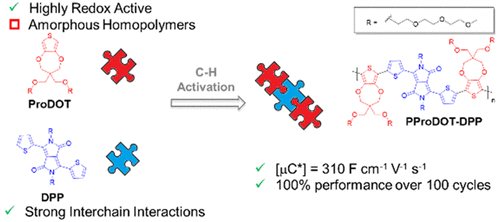当前位置:
X-MOL 学术
›
ACS Macro Lett.
›
论文详情
Our official English website, www.x-mol.net, welcomes your feedback! (Note: you will need to create a separate account there.)
Designing Donor–Acceptor Copolymers for Stable and High-Performance Organic Electrochemical Transistors
ACS Macro Letters ( IF 5.8 ) Pub Date : 2021-07-30 , DOI: 10.1021/acsmacrolett.1c00328 Xuyi Luo 1 , Hongguang Shen 1, 2 , Kuluni Perera 1 , Dung Trong Tran 1 , Bryan W Boudouris 1, 2 , Jianguo Mei 1
ACS Macro Letters ( IF 5.8 ) Pub Date : 2021-07-30 , DOI: 10.1021/acsmacrolett.1c00328 Xuyi Luo 1 , Hongguang Shen 1, 2 , Kuluni Perera 1 , Dung Trong Tran 1 , Bryan W Boudouris 1, 2 , Jianguo Mei 1
Affiliation

|
Organic electrochemical transistors (OECTs) are oft-used for bioelectronic applications, and a variety of OECT channel materials have been developed in recent years. However, the majority of these materials are still limited by long-term performance and stability challenges. To resolve these issues, we implemented a next-generation design of polymers for OECTs. Specifically, diketopyrrolopyrrole (DPP) building blocks were copolymerized with propylene dioxythiophene-based (Pro-based) monomers to create a donor–acceptor-type conjugated polymer (PProDOT-DPP). These PProDOT-DPP macromolecules were synthesized using a straightforward direct arylation polymerization synthetic route. The PProDOT-DPP polymer thin film exhibited excellent electrochemical response, low oxidation potential, and high crystallinity, as evidenced by spectroelectrochemical measurements and grazing incidence wide-angle X-ray scattering measurements. Thus, the resultant polymer thin films had high charge mobility and volumetric capacitance values (i.e., μC* as high as 310 F cm–1 V–1 s–1) when they were used as the active layer materials in OECT devices, which places PProDOT-DPP among the highest performing accumulation-mode OECT polymers reported to date. The performance of the PProDOT-DPP thin films was also retained for 100 cycles and over 2000 s of ON–OFF cycling, indicating the robust stability of the materials. Therefore, this effort provides a clear roadmap for the design of electrochemically active macromolecules for accumulation-mode OECTs, where crystalline acceptor cores are incorporated into an all-donor polymer. We anticipate that this will ultimately inspire future polymer designs to enable OECTs with both high electrical performance and operational stability.
中文翻译:

设计用于稳定和高性能有机电化学晶体管的供体-受体共聚物
有机电化学晶体管 (OECT) 常用于生物电子应用,近年来已开发出多种 OECT 通道材料。然而,这些材料中的大多数仍然受到长期性能和稳定性挑战的限制。为了解决这些问题,我们实施了用于 OECT 的下一代聚合物设计。具体来说,二酮吡咯并吡咯 (DPP) 结构单元与丙烯二氧噻吩基 (Pro-based) 单体共聚以产生供体-受体型共轭聚合物 (PProDOT-DPP)。这些 PProDOT-DPP 大分子是使用直接的直接芳基化聚合合成路线合成的。PProDOT-DPP聚合物薄膜表现出优异的电化学响应、低氧化电位和高结晶度,正如光谱电化学测量和掠入射广角 X 射线散射测量所证明的那样。因此,所得聚合物薄膜具有高电荷迁移率和体积电容值(即 μC * 高达 310 F cm –1 V –1 s –1 ),当它们用作 OECT 器件中的有源层材料时,这使 PProDOT-DPP 成为迄今为止报道的性能最高的累积模式 OECT 聚合物之一。PProDOT-DPP 薄膜的性能也保持了 100 次循环和超过 2000 秒的开关循环,表明材料具有强大的稳定性。因此,这项工作为设计用于累积模式 OECT 的电化学活性大分子提供了清晰的路线图,其中将晶体受体核结合到全供体聚合物中。我们预计这将最终激发未来的聚合物设计,使 OECT 具有高电气性能和操作稳定性。
更新日期:2021-08-17
中文翻译:

设计用于稳定和高性能有机电化学晶体管的供体-受体共聚物
有机电化学晶体管 (OECT) 常用于生物电子应用,近年来已开发出多种 OECT 通道材料。然而,这些材料中的大多数仍然受到长期性能和稳定性挑战的限制。为了解决这些问题,我们实施了用于 OECT 的下一代聚合物设计。具体来说,二酮吡咯并吡咯 (DPP) 结构单元与丙烯二氧噻吩基 (Pro-based) 单体共聚以产生供体-受体型共轭聚合物 (PProDOT-DPP)。这些 PProDOT-DPP 大分子是使用直接的直接芳基化聚合合成路线合成的。PProDOT-DPP聚合物薄膜表现出优异的电化学响应、低氧化电位和高结晶度,正如光谱电化学测量和掠入射广角 X 射线散射测量所证明的那样。因此,所得聚合物薄膜具有高电荷迁移率和体积电容值(即 μC * 高达 310 F cm –1 V –1 s –1 ),当它们用作 OECT 器件中的有源层材料时,这使 PProDOT-DPP 成为迄今为止报道的性能最高的累积模式 OECT 聚合物之一。PProDOT-DPP 薄膜的性能也保持了 100 次循环和超过 2000 秒的开关循环,表明材料具有强大的稳定性。因此,这项工作为设计用于累积模式 OECT 的电化学活性大分子提供了清晰的路线图,其中将晶体受体核结合到全供体聚合物中。我们预计这将最终激发未来的聚合物设计,使 OECT 具有高电气性能和操作稳定性。



























 京公网安备 11010802027423号
京公网安备 11010802027423号